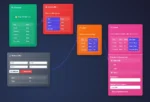
by tyler garrett | Jun 18, 2025 | Data Visual
Water sustains life, propels economies, and shapes the very fabric of civilizations. However, ensuring it’s consistently available—clean, safe, and abundant—requires strategic management built on solid data-driven insights. Hydrology data visualization tools empower decision-makers to navigate the complexities of water resource management with unmatched precision. As champions of data, analytics, and innovation, our consulting firm recognizes that visualizing hydrological information isn’t simply a convenience—it’s indispensable for identifying patterns, forecasting trends, informing policy, avoiding environmental catastrophes, and ensuring sustainable water usage for generations to come. Leveraging advanced visualization techniques, organizations can step beyond static numbers into a dynamic understanding that paves the way toward sustainable success. From streamlining workflows to anticipating water challenges, the right visualization tools can prove transformative. But which tools excel, how can they be implemented effectively, and what are the key considerations for organizations looking to gain actionable insights from hydrology data? Let’s explore further.
The Importance of Hydrology Data Visualization in Water Resource Management
Water resource management depends greatly on timely, accurate, and clearly presented data. The complexity of hydrological data requires visual representation to communicate insights effectively to stakeholders. Without visualization, large datasets risk becoming meaningless streams of numbers—difficult to interpret and actionable decisions elusive. Visualization solves this challenge, translating complex data into intuitive formats like horizon charts, heatmaps, scatterplots, and dashboards that stakeholders at any level can readily comprehend.
Visualization adds vital layers of meaning that raw data alone cannot reveal. It helps hydrologists pinpoint patterns, predict water shortages, and alert stakeholders to potential natural disasters like floods or droughts. By clearly communicating the statistical background and context, hydrology visualization tools go beyond basic data presentation, embedding critically needed statistical context into data visualizations to empower strategic decision-making.
Furthermore, transforming statistical data into visual forms increases accessibility and aligns various stakeholders around shared strategic goals. By adopting powerful visualization tools, organizations can involve nontechnical team members directly in critical planning and strategy discussions, ensuring better collaboration and improved resource allocation across the entire water management lifecycle. This proactive, visual strategy ultimately builds resilience into every aspect of water resource planning.
Selecting the Right Visualization Tools for Effective Hydrology Management
Choosing visualization tools involves understanding your organization’s specific hydrology data complexity, goals, and stakeholders’ technical proficiency. For instance, sophisticated tools like Tableau integrate seamlessly with powerful cloud platforms, such as Microsoft Azure, to deliver robust insights in real-time. Consulting experts in Azure consulting services can simplify the process, turning complex, aggregated water data from multiple sources into clear, visually appealing reports and dashboards optimized to your organization’s needs.
Furthermore, specialized visualization methods like violin plots can elegantly display data distribution, helping hydrologists quickly identify anomalies, deviations, and underlying distributions in water quality indicators or river flow volumes. A holistic understanding provided by such graphical representations enables stakeholders to make informed predictions and confidently develop crisis response strategies.
Visualization tools also ideally include built-in data governance features as outlined in our previous post on data governance for strategic decision-making. This ensures that businesses managing sensitive hydrological data can implement data governance compliance measures quickly and effectively—assuring data integrity, accountability, and regulatory compliance while maintaining high trust among stakeholders.
Data Analytics and Engineering for Advanced Hydrology Visualization
Behind compelling water management visualizations is rigorous data analytics and impeccable data engineering. To fully leverage data visualization tools, organizations must first build strong technical foundations through professional data engineering practices. Clean, properly formatted data sets avoid critical errors such as integer overflow—a technical but serious issue detailed in our exploration of why integer overflow kills analytics effectiveness. Solid engineering principles and thoughtful database design prevent misleading insights and ensure accurate representations that stakeholders can rely upon confidently.
Moreover, comprehensive tools facilitating easy adjustments to data models enable swift reaction during crises like floods. Tools such as SQL-based operations like UPDATE statements to modify existing data or the ALTER TABLE function to swiftly change table structures can quickly adapt datasets to evolving hydrological scenarios. Adaptable data visualization backed by agile analytics tools promotes a responsive strategy: a critical advantage in water resource management scenarios frequently impacted by rapidly changing environmental factors.
Organizations relying on robust analytics foundations are better positioned to extract the highest value from visualizing hydrological data. Moreover, they pay closer attention to issues such as regulatory reporting and lineage, enabling transparency and proper traceability throughout every step of analysis and reporting processes. Strategic use of analytics and data engineering surfaces hidden insights and delivers dynamic visuals to efficiently inform decision-makers.
Real-World Applications and Impacts of Visualizing Hydrology Data
Across multiple industries, visualizing hydrological data has showcased its strategic value. Municipalities employ these advanced analytics and visualizations to anticipate threats to drinking water, make strategic infrastructure investments, and protect residents from water shortages or flooding. In the agricultural sector, visualization helps farmers make critical irrigation scheduling decisions, thereby improving crop production and conservation efforts. Similarly, visualization actively enhances decision-making across various business sectors, as described in our article on analytics improving customer experiences.
Financially, businesses leveraging accurate visualizations prevent unnecessary expenditures and costly errors. Moreover, proper visualization promotes proactive decision-making and avoids typical problems often encountered in sectors such as finance, described in our post on risks from over-reliance on data. Real-world hydrology data visualization helps business managers understand the full financial and environmental impacts behind water resource projects, ensuring successful projects that meet regulatory compliance, stakeholder expectations, and long-term sustainability goals.
Furthermore, environmental oversight and strategic interventions rely heavily on clear visuals of complex hydrological data. Policymakers, nonprofits, and regulatory teams frequently turn insights derived from these visualizations directly into actionable policies, programs, and communication strategies that encourage stakeholders’ cooperation and improve environmental advocacy.
The Future of Water Management Through Innovation in Visualization
The integration of cutting-edge technologies like artificial intelligence (AI), Internet of Things (IoT) sensors, predictive modeling, and cloud computing suggests a promising future for visualization tools in hydrology. As technology progresses, new means of gathering data and analyzing it dynamically will lead to visualizations that are more precise, predictive, and effective than ever.
AI-driven visualization solutions can dramatically reduce time-to-insight, enabling experts to react quicker and with greater accuracy. Meanwhile, cloud integration ensures visualizations are always current, scalable, and universally accessible, creating a seamless data-driven decision-making environment. With more advanced visualization techniques entering mainstream hydrology, it’s becoming clearer that powerful innovation and strategic visualization tools are indispensably molding the future of sustainable water resource management.
The potential found in visual data isn’t mere innovation; rather, it’s becoming an absolute necessity. Organizations that embrace and master these powerful data visualization methods position themselves advantageously for whatever complexities future hydrological scenarios hold. They achieve better sustainability outcomes, efficient resource use, and ultimately build resilient systems that improve people’s lives.
Thank you for your support, follow DEV3LOPCOM, LLC on LinkedIn and YouTube.

by tyler garrett | Jun 12, 2025 | Data Processing
Imagine orchestrating the morning rush hour in a bustling city, each commuter representing a piece of data heading rapidly through interconnected streets, all converging towards well-defined destinations. Without careful planning and management, chaos reigns supreme. In the world of software architecture and data processing, fan-out/fan-in patterns offer systematic traffic control—splitting tasks into concurrent operations (fan-out) and subsequently consolidating those results into meaningful outputs (fan-in). Executed properly, this approach empowers your analytics pipelines to handle colossal volumes of data swiftly while maintaining computational efficiency. Let’s dive deeper into how fan-out/fan-in patterns strengthen analytics, protect pipelines from bottlenecks, and deliver insights faster without sacrificing clarity or stability.
Understanding Fan-Out and Fan-In in Modern Data Architectures
The crux of any high-performance data processing system lies in its ability to efficiently parallelize workloads, transforming complex, intensive tasks into manageable pieces spread across multiple resources. This is precisely the strength of the fan-out/fan-in approach. At the fan-out phase, tasks are segmented and dispatched simultaneously across parallel paths, dramatically increasing throughput and reducing the latency inherent in traditional sequential processing. Conversely, the fan-in step aggregates these dispersed process results, recombining multiple workstreams back into a single coherent outcome.
In practice, fan-out/fan-in implementations imply a robust orchestration capability, particularly suited to distributed systems, event-driven applications, and real-time analytics workloads. Ensuring data integrity, streamlining final interpretations, and carefully monitoring performance metrics are essential to avoid overwhelming system resources. A disciplined implementation leads to smoother operations, preventing backpressure bottlenecks from crippling downstream systems—an obstacle often faced in large-scale streaming data scenarios.
Moreover, this architectural choice doesn’t only leverage concurrent processing power but also introduces intelligent load-balancing strategies that optimize hardware resources and enhance computational agility. Implementing fan-out/fan-in thoughtfully helps organizations navigate volatile workloads and fluctuating data volumes with confidence and stability.
The Mechanics: How Fan-Out Enables Parallel Efficiency
At its most fundamental level, fan-out distributes work broadly. During this stage, the master algorithm assigns tasks to various computing resources simultaneously—effectively transforming a complex task from a sequential bottleneck into parallel subtasks. By designating specific subtasks to available computing nodes or serverless functions, fan-out architectures drastically reduce overall response times and empower systems to scale horizontally, accommodating a wide range of concurrent workloads effortlessly.
Empowering analytics functions through fan-out commonly involves segmentation tasks for processing expansive datasets or running machine learning models across distributed compute instances. For example, consider semantic embedding generation, an analytic process whose computational load can be partitioned into independent embedding tasks—each running concurrently, drastically speeding up semantic understanding for business intelligence insights.
However, unchecked parallelism risks creating more chaos than value. Therefore, developers and architects must carefully manage partitioned tasks’ granularity, ensuring each operation remains efficient. Intelligent monitoring and management tools ensure optimal resource allocations and peak parallel execution. Leveraging powerful cloud computing environments in conjunction with fan-out design allows analytics tasks to operate at breathtaking scales, empowering organizations to innovate faster and stay ahead of competition.
Consolidating Results with Fan-In: From Distributed Chaos to Unified Clarity
While fan-out capitalizes on parallelism, fan-in meticulously consolidates the independently generated results into meaningful aggregates. It’s in this crucial convergence phase that the output translates effectively into actionable business insights. For example, merging parallel analyses from separate market segments, consumer demographics, or data sources ensures a holistic and nuanced understanding that no singular analysis could replicate alone.
Strategically, fan-in bridges independent computations into actionable results through structured aggregation, reconciliation logic, correlation analysis, or more sophisticated business decision frameworks. In analytics workflows, this stage ensures data integrity—emphasizing the critical importance of appropriate data representation—to avoid skewed conclusions resulting from improper scaling or misaligned axes.
Careful orchestration during fan-in also mitigates potential resource contention and ensures that conclusions drawn from distributed workstreams are accurate and timely. This attention to detail pays dividends in reliability and trustworthiness—especially critical in strategic analytics outputs like executive dashboards. Accurate consolidations empower executives to confidently rely on real-time aggregated insights for business-critical decisions without fear of misleading representations or slow results delivery.
Best Practices for Managing Fan-Out and Fan-In Complexity
While fan-out/fan-in architecture promises unparalleled processing efficiency, its benefits are not without complexity. Gaining maximum value entails addressing these complexities proactively—with disciplined orchestration strategies, strategic partitioning, and robust result aggregation patterns. Architects must consider multiple factors, such as system resource calibration, messaging throughput management, and stateful versus stateless task executions. This meticulous planning not only prevents chaos but also boosts overall system reliability and data accuracy.
To ensure success, invest wisely in effective monitoring practices to guide workload assignments. Keep close tabs on task distribution granularity—larger tasks may simplify workflow management but may undermine parallel efficiency, while overly granular operations could introduce significant orchestrational overhead. Based on monitoring outcomes, utilize flexible cloud environments or targeted hourly expert consulting support to tackle nuanced challenges effectively and in real-time without committing long-term resources.
Furthermore, shared data definitions and standardized enterprise glossaries are critical for managing system technicalities at scale. Ensuring data consistency and precision through clear terminology reduces complexity dramatically. Establishing precise enterprise glossary standards for homonyms and synonyms supports result clarity during the fan-in stage, protecting against contextual misalignments during final aggregations. With these attentive strategies, complexity remains manageable, and system performance reaches optimal heights.
Pushing Analytics Boundaries: Leveraging Advanced Patterns in Fan-Out / Fan-In Architectures
When executed strategically, fan-out/fan-in enables organizations to explore frontier technologies tailored specifically for analytics integration. Machine learning and modern predictive frameworks, powered by parallel computations, offer decision-makers deeper insights previously unimaginable at scale. For instance, applying fan-out/fan-in architectures toward sophisticated result aggregations like causal inference frameworks unlocks enhanced decision-support capabilities, enabling leaders to predict complex relationships and anticipate business impacts accurately.
Integration of artificial intelligence (AI) agents into fan-out/fan-in workflows further elevates analytical capabilities. AI-driven processes amplify analytics potential by autonomously orchestrating segmentations, dynamically allocating resources, and intelligently aggregating results. Deploying expert AI agent consulting services helps precisely navigate the integration of fan-out/fan-in with strategic AI-driven components, maximizing analytic potential and fueling ambitious business innovations.
As the complexity of business scenarios escalates, reliance on fan-out/fan-in patterns combined with cutting-edge techniques will become indispensable for organizations aspiring to leadership positions. Leaders who recognize and seize upon these opportunities proactively establish competitive, flexible architectures prepared to tackle the processing demands and analytical needs of future markets—fully prepared to harness analytics-driven insights at scale efficiently and reliably.
Accelerating Your Journey Toward Fan-Out/Fan-In Mastery
The power and potential of fan-out/fan-in are clear, yet implementing it optimally requires deep strategic thinking, thorough planning, and precise execution. At each step along the path, partnering with seasoned analytics specialists can smooth transitions, accelerate timelines, minimize missteps, and maximize your immediate value from parallel data processing.
Taking intentional early steps can dramatically ease complexity. Begin by clearly defining analytics goals, mapping data dependencies, and assessing your current state—then progressively transform your infrastructure toward effective parallel architectures. With focused, timely advice, incremental implementations, and expert guidance, your organization achieves mastery faster—geared confidently towards scalable, reliable analytics excellence.
Now more than ever, parallel processing via fan-out/fan-in represents not just technological advancement but an essential competitive differentiator. Embrace the structured chaos strategically, and your business will thrive, empowered with analytic insights fast enough, accurate enough, insightful enough to perfectly fuel innovation-driven success.

by tyler garrett | Jun 12, 2025 | Data Processing
In the intricate world of data management, the manner by which you structure your information can make or break the efficiency of your technology stack. As decision-makers strive to harness the power of their growing data assets, understanding variable-length and fixed-width record storage methods becomes paramount. It’s an intersection of innovation and pragmatism—where legacy systems coexist alongside modern data engineering practices, and navigating this balance can yield remarkable analytical outcomes. In this guide, we’ll unpack the concept of variable-length records, explore how they function within traditionally fixed-width architectures, and ultimately demonstrate how intelligent data solutions can streamline your operations and enhance strategic decision-making.
Understanding Fixed-Width and Variable-Length Record Structures
At the foundation of data storage lie two critical concepts—fixed-width and variable-length records. Fixed-width records assign uniform space allocation across all fields, regardless of actual data length, making it straightforward to calculate storage requirements and rapidly access data. This structure, however, comes at the cost of efficiency, as empty spaces accumulate due to unused field slots, especially if data varies significantly in size. Historically, fixed-width records were the bedrock of database schemas due to their ease of managing data alignment and fast read performance within legacy systems.
Conversely, variable-length records flexibly adjust their storage space according to the actual data size. This adaptability minimizes waste, allows for smoother scalability, and dramatically improves storage efficiency—a crucial advantage in an era where data volumes continually escalate. However, implementing variable-length records within systems accustomed to fixed configurations involves carefully designed integration strategies focused on compatibility and efficient data access.
At Dev3lop, our experts frequently help businesses evaluate their existing data storage strategies. Our advanced analytics consulting services empower organizations to optimize their database infrastructure, ensuring they harness technology’s full potential for data-driven initiatives.
The Advantages of Embracing Variable-Length Records
Opting for variable-length records rather than maintaining a rigid fixed-width approach can significantly enhance your operational capabilities. By aligning storage needs precisely to data size, organizations experience impactful resource conservation—reduced disk usage and lower data transmission volumes, resulting in cost savings and higher efficiency. Variable-length records also expedite processing tasks, smaller storage footprint means servers can retrieve and manipulate datasets more rapidly, enhancing end-to-end analytics processes that rely on speedy data ingestion.
Furthermore, handling diverse datasets—such as logs, unstructured text, and user-generated content—becomes significantly more straightforward with variable-length storage. The dynamic nature of modern digital data demands responsive strategies, and variable-length records can effectively accommodate unpredictable growth and variety. As businesses increasingly leverage advanced analytical techniques, like those presented in our detailed breakdown on enabling data-driven decision-making, using the right data storage methods ensures analytics workloads execute efficiently. Such adaptability improves real-time analytics integration, allowing businesses to strategically pivot based on emerging data-driven insights.
Our team at Dev3lop understands the importance of optimizing your data foundation. For instance, our insights on tools and technologies used for data analytics identify storage methods as foundational to effective data performance—highlighting why selecting correct data record structuring techniques influences future analytical capabilities.
Integrating Variable-Length Records into a Fixed-Width Environment: Challenges and Solutions
Navigating the shift from a traditional fixed-width storage method to embracing the variability of modern flexible datasets requires careful consideration and planning. One primary challenge emerging is the complexity around indexing and retrieval algorithms—methods traditionally optimized for fixed-width records become more intricate when handling variability. Navigating these complexities demands highly skilled data professionals, and our breakdown of the differences between a data engineer and a data analyst clarifies what skillsets your organization may require to smoothly implement variable-length data structures.
Key solutions to facilitating this integration include implementing strategic metadata management, enhancing your data indexing schemes, and using specialized database management systems geared toward schema flexibility. Adopting robust metadata strategies ensures that records remain easily discoverable, properly indexed, and retrievable despite their variable dimensions. Additionally, building effective data management frameworks, as explained in our guide on streamlined database management best practices, will assist organizations in adapting existing infrastructure seamlessly to newer, more flexible data standards.
At Dev3lop, our data architects leverage tailored optimization approaches to assist client enterprises in effectively integrating these modern methodologies, maximizing the strengths of legacy systems while introducing innovative efficiencies.
Real-Time Analytics & Optimization through Variable-Length Storage Adoption
Real-time analytics depend heavily on efficient storage and retrieval, making variable-length record management enormously beneficial. By reducing storage and transmission overhead, variable-length records facilitate the rapid analytical processing essential to meet today’s increasingly real-time analytics demands. Our research, such as the article examining real-time dashboard performance benchmarks (WebGL vs Canvas), underscores how critical optimized data structures are in delivering timely insights and interactive analytics experiences.
To fully leverage real-time insights, analytical infrastructure must handle streaming event data efficiently, reliably, and accurately. Variable-length records support flexible data pipeline processing, especially beneficial for sessionized analytics datasets like those explained in our practical guidelines on session window implementation for user activity analytics. The dynamic nature of sessionized events—with varying data payload length and size—makes variable-length records an ideal option to smoothly capture, store, and analyze ever-changing user engagement data.
For organizations ready to transition into a dynamic and more responsive real-time analytics environment, Dev3lop provides tailored solutions in designing, optimizing, and scaling data assets bolstered by variable-length storage methods.
How to Strategically Manage Data Pipelines and Data Warehouses Amid Variable Data Structures
For optimal management of variable-length records within warehouses and pipelines, implementing effective pipeline monitoring and optimized warehouse design is crucial. Utilizing meaningful analytics signals, like those explained thoroughly in our guide on golden signals for data pipelines visualization, allows data teams to identify issues proactively—simplifying troubleshooting and optimizing performance for pipelines frequently challenged by variability.
Incorporating visualization techniques, as outlined in our guide to data pipeline dependency graph visualization, facilitates enhanced management insights. Visualizing dependencies and pipelines’ complex interactions enables easier identification of optimization opportunities arising from data variability. Complementing these efforts is a robust strategic understanding of data warehouse fundamentals and best practices for architecture, clearly detailed in our easy-to-follow beginner’s guide to data warehousing. Combining these insights with the flexibility of variable-length records allows your organization to optimize storage resources dynamically, manage growth strategically, and maintain high analytics performance under high-frequency workload scenarios.
Our Dev3lop experts are ready to help organizations amplify their analytics potential through strategic design of efficient data pipelines and warehouse environments fully optimized for variable-length record scenarios.
Conclusion: Navigating Efficiency & Innovation in Your Data Landscape
The shift from fixed-width limitations to the adaptive advantages of variable-length records can fuel greater efficiency and advancements in analytics capabilities. With new demands continually placed upon organizational decision-makers, staying competitive hinges upon data strategy innovation and effective alignment with real-time analytical expectations.
Whether you’re seeking guidance on executing this transition smoothly or optimizing your existing infrastructure for scalability and flexibility, experienced partners can make this process seamless. At Dev3lop, we specialize in leveraging decades of analytical expertise, enabling organizations across industries to realize cutting-edge analytics capabilities with precision and ease. We invite you to reach out and start your journey toward data efficiency, adaptability, and innovation today.

by tyler garrett | Jun 12, 2025 | Data Processing
Imagine managing large-scale applications and data environments without ever fearing downtime or data loss—sounds like a dream, doesn’t it? As complexity scales, the reliability of your systems hinges on the right strategy for state management. At the intersection of robust data analytics, cutting-edge software development, and strategic innovation, the debate between checkpoints and snapshots emerges front and center. Do you find yourself puzzled over these terms? You’re not alone. Today, we’ll break down these concepts clearly, confidently guiding you toward strategic insights, enabling smarter data-driven decisions, and ensuring your stateful applications remain operational without the looming specters of costly downtime or data corruption.
Understanding the Core: Checkpoints and Snapshots Explained
Before diving into strategic considerations, let’s clarify exactly what checkpoints and snapshots represent in state management contexts. These two approaches frequently appear in distributed computing, databases, and modern data engineering environments, yet distinct differences in how they operate can dramatically impact your workflow efficiency.
Checkpoints: Consistent States Captured Periodically
A checkpoint is often understood as a known good state of a system at a specific point in time. Typically integrated directly into applications or databases, checkpoints are taken periodically at predefined intervals. Imagine automatically saving your work-in-progress document periodically so, in the worst case, you only lose a few recent edits. In more complex data streaming environments, pipelines implemented with idempotent processing methodologies leverage checkpointing to save application state, enabling rapid recovery and guaranteeing reliable, repeatable outcomes without duplicated effort or data loss. Simply put, checkpoints ensure that recovery becomes seamless by saving a “known good state” periodically.
Snapshots: Comprehensive, Point-in-Time Copies
A snapshot, in contrast, is akin to capturing an instantaneous copy of data at a given moment. Imagine taking a photograph of your database at exactly 3:00 PM—a static image reflecting exactly the data’s condition at that exact moment, unaffected by real-time operations happening subsequently. In modern data engineering scenarios, snapshots play a pivotal role in disaster recovery and backup management. Snapshots are beneficial when you need comprehensive rollback states, full data audits, or historical analyses. For understanding visualization needs or iterative development in analytics, snapshots can prove invaluable for quick experimentation—an example of bringing flexibility into visualization testing could be found in our guide on creating a basic bar chart or line graph for data insights.
The Strategic Choices: When to Choose Checkpoints or Snapshots
While both checkpoints and snapshots seem closely related on the surface, your business context will define the appropriate choice clearly. A strategic determination rests upon several factors including recovery objectives, latency sensitivity, and analytical requirements.
Rapid Recovery and Continuous Operations: Favor Checkpoints
When continuity and minimal recovery time are paramount, checkpoints clearly outshine snapshots. By regularly storing incremental states, checkpoints optimize the recovery process—enabling your operations to resume rapidly after any interruption. Consider, for instance, modern streaming and low-latency data ingestion platforms where quick recovery after transient failures is essential. Using checkpoints—leveraged through concepts like modern ELT methodologies rather than traditional ETL—reduces downtime and enhances operational reliability. For decision makers seeking continuous uptime, checkpoints present the preferable strategic choice.
Historical Data Integrity and Comprehensive Backups: Opt for Snapshots
Conversely, snapshots provide complete, holistic visibility into your data at specific historical points. When audit trails or full restore capabilities outweigh the considerations of continuous incremental state management, snapshots stand unrivaled. For industries such as finance or healthcare—where regulatory compliance increasingly imposes stringent data integrity requirements—snapshots are crucial for comprehensive backup strategy and thorough rollback capability. Choose snapshots if your firm prioritizes extensively analyzing past states, tracing precise data lineages, or securely managing historical data compliance needs without compromise.
Performance and Scalability: Comparing Resource Impacts
Beyond recovery speed or historical copies, checkpoints and snapshots differ significantly in terms of their resource utilization and scalability impact—two critical factors for any robust enterprise infrastructure.
Checkpoint Efficiency and Minimal Impact on Resources
Strategically adopting frequent incremental checkpoints can enhance system efficiency dramatically. Since checkpoints only capture incremental state changes, they naturally reduce storage requirements and minimize the demand on resource-intensive performance overhead that snapshots often imply. In scenarios where fast-paced data flow and data-driven revenue optimizations are at stake, lightweight checkpoints enable agile and responsive data platforms without significant penalties on compute resources or bandwidth.
Snapshots: Resource Trade-offs for Comprehensive Data Protection
However, it’s crucial to recognize snapshots impose additional resource commitments. When capturing full images of data at a specific instant, snapshot strategies inherently require higher bandwidth, processing overhead, and extensive storage infrastructures. Despite higher consumption, snapshots provide unmatched confidence and traceability for comprehensive data backups and audits. Decision-makers deploying snapshots strategically realize potential trade-offs in performance for the greater resilience and compliance these full data captures facilitate—particularly essential when holding crucial business records accountable to regulatory scrutiny or compliance audits.
Integrating Checkpoints and Snapshots: An Optimized Hybrid Approach
The tech-savvy organization understands that these aren’t mutually exclusive methodologies—a skillful blending of checkpoints and snapshots is often the strongest solution, empowering businesses with optimal risk management along with streamlined resource consumption.
Leveraging Combined Approaches for Ultimate Reliability
Consider an environment where both approaches complement one another strategically. Regular lightweight checkpoints ensure operational continuity, rapid recovery, and seamless maintenance of real-time data pipelines and mission-critical data analytics. Meanwhile, periodic snapshots provide long-term historical archiving or compliance-friendly backups. Leadership aiming for strategic agility can adopt this hybrid approach—to build resilience using snapshotting, paired with fast recovery enabled by checkpointing, replacing outmoded approaches identified in our piece on overrated tools in data engineering.
Implementing Smarter Strategies with Expert Guidance
Transitioning effectively to integrated state management strategies requires deep expertise in data systems architecture and foresight. Organizations looking to fully unlock these comprehensive strategies often benefit from external expertise—such as industry-leading guidance available from specialized consulting services in analytics and innovation like our AI agent consulting services. By entrusting implementation to informed specialists, companies strategically position themselves to stay versatile, adaptive, and scalable—fundamentally necessary as technology accelerates innovation and reshapes competitive landscapes.
Security Considerations: Ensuring Proper Access Controls
An integral facet of state management often overlooked at the strategy level is security—particularly managing appropriate access permissions to stored states. Whether checkpointing or snapshotting, protecting access from unauthorized individuals is critical both from a data privacy standpoint and regulatory compliance.
Managing and Revoking Access—Practical Imperatives
Trustworthy state management mandates regular monitoring, access reviews, and rapid privilege revocation. Organizations handling sensitive or confidential states must develop robust strategies for revoking privileges and managing access control effectively. Integrating checkpoints or snapshots into your operations should occur alongside clear protocols for secure management, thus minimizing risk exposure, eliminating unauthorized changes, and keeping operational integrity intact.
Adapting Strategically for Compliance & Data Governance
Proactive compliance initiatives dictate stringent data governance measures. Secure checkpoints and snapshots allow for audits or forensic analyses, essential when tackling critical incident recovery or regulatory audits. For organizations focused on adaptive, scalable security strategies, hourly software consulting models can offer nuanced strategic insights—as detailed further in our exploration into why hourly software consulting represents the future of scalable innovation and flexibility.
Conclusion: Mastering State Management
By thoroughly understanding, strategically deploying, and securing checkpoints and snapshots, data-intensive organizations confidently manage operational integrity, foresee potential interruptions proactively, and respond swiftly to challenges. Employing checkpoints ensures immediate continuity, optimized performance, and incremental protection, while robust snapshots enhance historical effectiveness, audit agility, and regulatory precision. Ultimately, expertly combining checkpoints and snapshots presents an ideal, future-proof roadmap—removing the tears from your state management strategy.

by tyler garrett | Jun 12, 2025 | Data Processing
Every organization aims to become data-driven, but not every organization enjoys unlimited resources to achieve that vision. Leaders tasked with managing data-rich environments find themselves confronting a perennial question: Should we embrace cost-effective open-source data pipelines or invest in robust enterprise solutions? While open-source pipelines promise flexibility, affordability, and a vibrant community, enterprise tools provide reliability, support, and often simpler management. As analytics technologies evolve, the lines between the two increasingly blur, elevating the debate into a nuanced conversation for decision-makers. Recognizing this delicate balance is critical, and strategic insights can make the difference in unleashing your organization’s full data potential—even on a tight budget.
Understanding Key Differences Between Open Source Data Pipelines and Enterprise Solutions
At first glance, open-source and enterprise-level data pipeline tools may accomplish similar goals: orchestrating the seamless movement and transformation of data across systems. However, beneath the surface, their differences reveal distinct implications for cost, configuration, customization, and scalability. Open-source tools like Apache Airflow, Kafka, or dbt offer transparency in their architecture and potentially large cost savings upfront, typically only costing the effort needed to manage and customize the systems internally.
In contrast, enterprise solutions such as Amazon Redshift provide comprehensive managed capabilities, reducing the overhead of internal DevOps and engineering maintenance. Moving to managed cloud-based analytics solutions offers considerable strategic advantage—eliminating internal administrative overhead allows businesses to focus precisely on deriving insights from data. Although enterprise systems tend to command higher licensing fees, they can ultimately reduce the complexity and operational overhead by providing dedicated vendor support, reliable scalability, robust security standards, and pre-integrated compliance frameworks. Even better, partnering with a trusted vendor can significantly streamline complex analytical workflows. Our consultants, for instance, specialize in Amazon Redshift consulting services to ensure businesses leverage enterprise pipelines effectively.
Cost Implications: The Hidden Expenses of Open Source vs. Enterprise Solutions
Perhaps one of the most critical considerations in the open source versus enterprise debate is the realistic assessment of hidden costs. On paper, open-source might look primarily free—after all, there are usually no license fees. Yet, in practice, organizations must account for the expenses of engineering talent, ongoing maintenance, infrastructure, security enhancements, compliance adjustments, and tool customization that come with open-source setups. Additionally, less tangible costs such as opportunity costs of delays or compromises in reliability can significantly impact total cost of ownership.
By contrast, enterprise solutions come with clearly defined and visible licensing, subscription, or usage-based fees upfront. These platforms usually bundle support, extensive documentation, compliance certifications, automated infrastructure management, and managed security measures. While initial sticker prices can make budgeting appear challenging, managed enterprise data pipeline tools may reduce or contain long-term operational costs by eliminating unplanned difficulties, reducing downtime, and providing ready scalability.
When calculating these numbers carefully, many clients are surprised to discover that comprehensive enterprise systems wind up cost-competitive or even lower priced than open source approaches over the long haul. Savvy leaders understand that carefully calculated cost analyses that weigh customization time, talent needed, and operational overhead can tip the scales toward enterprise.
Architectural Flexibility: Can Open Source Keep Pace with Enterprise Solutions?
Open-source solutions often win favor by providing unmatched configurability and flexible integrations, facilitating complex real-time and batch data processing protocols like fan-out fan-in parallelization patterns. They excel in scenarios requiring specific customization, precise optimization, and integration with niche tools across the technology stack. Furthermore, the open-source ecosystem grants teams unprecedented freedom to innovate rapidly, experiment, and implement novel change data capture topologies for event-driven analytics with relative agility.
On the other hand, modern enterprise data platforms respond to growing customer demand for flexibility too, offering largely API-driven architectures to enable plug-and-play components and seamless integration into existing cloud-native environments. Vendors have recognized the need to offer infinite scalability, flexible customizations, and integration solutions, adopting agile development methodologies modeled closely after open-source principles.
The architectural gap between open source and enterprise pipelines has notably narrowed. Enterprise solutions now deliver on-demand scaling, sophisticated zero-copy data movement, and robust integrations APIs, closely competing against open-source alternatives for flexibility and adaptability. While open-source enthusiasts firmly argue in favor of total flexibility, enterprise solutions increasingly challenge this perception with powerful, developer-friendly ecosystem models and minimal vendor lock-in.
Security, Compliance, and Governance: A Decisive Factor
Data security, compliance, and governance frameworks critically impact your choice of open source vs. enterprise solutions. Open-source systems require significant engineering efforts to meet stringent compliance regulations and complex security protocols. Teams using open-source solutions must consider intricate aspects ranging from manual patches for security vulnerabilities to user consent management, as explained in our in-depth analysis of consent management integration with data processing.
Enterprise solutions, alternatively, consistently offer built-in security, detailed compliance frameworks, industry-standard certifications, and in-depth confidentiality classification rules, ultimately alleviating high-pressure engineering and DevOps security challenges. This makes enterprise platforms invaluable for enterprise-sized deployments, those working under strict regulatory conditions, or sensitive data segments like healthcare and finance.
Decision-makers must carefully evaluate their security requirements, regulatory needs, and available skillsets. If an organization operates within highly regulated spaces or businesses deeply protective of user privacy and sensitive data assets, it might justify the enterprise-choice premium due to inbuilt compliance and robust enterprise-grade security models.
Capabilities to Innovate: Analytics and Advanced Pipeline Features
Modern organizations increasingly seek sophisticated analytics capabilities like hyperdimensional computing approaches, interactive visualizations through zoom-and-pan implementations, or innovative storytelling techniques such as scrollytelling for data narratives. Although open-source tools can be extensively customized, they often lack seamless integration and require time and engineering resources to build compelling capabilities from scratch.
Enterprise analytics platform vendors progressively recognize the strategic value offered by compelling, out-of-the-box advanced analytics features. Ready-made, tested functionalities allow analysts to quickly experiment and prototype solutions without heavy upfront coding, empowering accelerated data-driven innovation initiatives. Vendors often innovate faster, pushing advanced analytics workloads, machine learning techniques, and sophisticated visualization outputs effortlessly into pipelines, significantly reducing the time-to-insights.
For example, data analytics implementations aimed at enhancing civic infrastructures, like our case study on improving transportation in Austin, Texas, benefit immediately from enterprise solutions’ built-in analytical features, enabling faster deployment and shorter innovation cycles. This time-to-value can prove vital for organizations needing rapid insights to drive mission-critical decisions.
Long-term Reliability and Maintainability: Which Approach Wins?
Reliability is arguably as crucial as cost-effectiveness when building a successful data infrastructure. Open-source solutions rely on teams maintaining their own stability, updating frequently, and applying continuous enhancements to ensure system health. For smaller teams without extensive engineering resources, maintaining such stability creates difficult challenges.
Enterprise solutions alleviate maintenance burdens significantly by ensuring consistent updates, dedicated support channels, guaranteed uptime, and robust reliability. Rigorously maintaining pipeline health is outlined further in our in-depth exploration of designing pipelines for reliability and maintainability. Organizations can proactively prevent downtime and performance degradation issues that otherwise disrupt decision-making or prevent access to business-critical data.
Ultimately, enterprise solutions may offer better stability, scalability, and stress-free management, allowing business leaders and analytics experts to dedicate intellectual power toward deriving business value through analytics rather than wrestling with immediate tech challenges.
Conclusion: Making Strategic Choices
Cost-driven organizations must analyze more than baseline sticker-prices to strategically weigh open-source versus enterprise data pipeline technologies. Careful assessments of total cost, security compliance, innovation capability, maintaining reliability, and administrative overhead will decisively guide this critical choice. Ultimately, your selection should align with your organizational cloud adoption strategy, existing talent pool, and critical business priorities.
Tags: Data pipeline costs, Open source vs enterprise, Data analytics strategy, Cloud analytics, Cost comparison, Data-driven innovation























